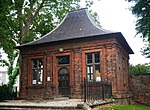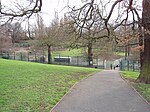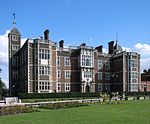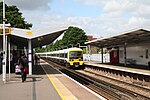Charlton House
1612 establishments in EnglandBuildings and structures in the Royal Borough of GreenwichCharlton, LondonCountry houses in LondonDefunct hospitals in London ... and 8 more
Grade I listed buildings in the Royal Borough of GreenwichGrade I listed houses in LondonHealth in the Royal Borough of GreenwichHospitals disestablished in 1919Hospitals established in 1918Houses completed in 1612Houses in the Royal Borough of GreenwichUse British English from May 2020

Charlton House is a Jacobean building in Charlton, within the Royal Borough of Greenwich in south-east London. Originally it was a residence for a nobleman associated with the Stuart royal family. It later served as a wartime hospital, then a museum and library, and is now a community centre.
Excerpt from the Wikipedia article Charlton House (License: CC BY-SA 3.0, Authors, Images).Charlton House
The Village, London Charlton (Royal Borough of Greenwich)
Geographical coordinates (GPS) Address External links Nearby Places Show on map
Geographical coordinates (GPS)
| Latitude | Longitude |
|---|---|
| N 51.48062 ° | E 0.03714 ° |
Address
Charlton House
The Village
SE7 8UG London, Charlton (Royal Borough of Greenwich)
England, United Kingdom
Open on Google Maps










